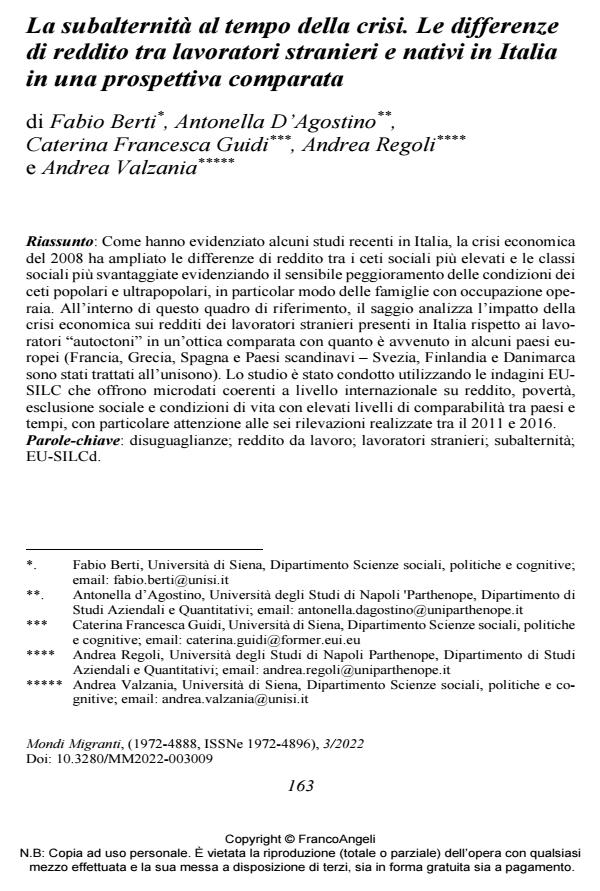The subalternity during the crisis. The income differences between foreign and native workers in Italy in a comparative perspective
Journal title MONDI MIGRANTI
Author/s Fabio Berti, Antonella D’Agostino, Caterina Francesca Guidi, Andrea Regoli, Andrea Valzania
Publishing Year 2022 Issue 2022/3
Language Italian Pages 16 P. 163-181 File size 226 KB
DOI 10.3280/MM2022-003009
DOI is like a bar code for intellectual property: to have more infomation
click here
Below, you can see the article first page
If you want to buy this article in PDF format, you can do it, following the instructions to buy download credits

FrancoAngeli is member of Publishers International Linking Association, Inc (PILA), a not-for-profit association which run the CrossRef service enabling links to and from online scholarly content.
As some recent studies in Italy have shown, the 2008 economic crisis has widened the income differences between the upper social classes and the most disadvan-taged social classes. Also the analyses on wealth inequalities confirm the signifi-cant worsening of the conditions of working and ultra-popular classes, in particular of families with worker employees. Within this framework, the essay analyses the impact of the economic crisis on the incomes of foreign workers present in Italy compared to native workers in a comparative perspective to what happened in some European countries: France, Greece, Spain and Scandinavian countries (Sweden, Finland and Denmark were treated in unison). The study has been con-ducted using EU-SILC surveys which offer international microdata on income, poverty, social exclusion and living conditions with high levels of comparability between countries and times, with particular attention to the six surveys carried out between 2011 and 2016.
Keywords: income differences; incomes; foreign workers; subalternity; EU-SILC surveys.
- Chi semina sfruttamento raccoglie campagne, di sensibilizzazione. Il ruolo delle diaspore nel contrasto allo sfruttamento lavorativo Stefania Peca, Pierluigi Musarò, in WELFARE E ERGONOMIA 1/2024 pp.163
DOI: 10.3280/WE2024-001012 - Il welfare aziendale territoriale: una prima mappatura dei casi italiani Valentino Santoni, in WELFARE E ERGONOMIA 1/2024 pp.185
DOI: 10.3280/WE2024-001014
Fabio Berti, Antonella D’Agostino, Caterina Francesca Guidi, Andrea Regoli, Andrea Valzania, La subalternità al tempo della crisi. Le differenze di reddito tra lavoratori stranieri e nativi in Italia in una prospettiva comparata in "MONDI MIGRANTI" 3/2022, pp 163-181, DOI: 10.3280/MM2022-003009